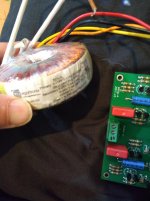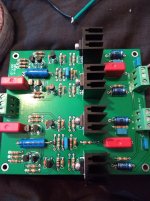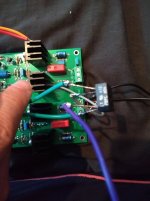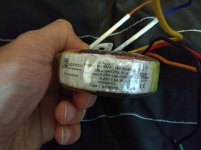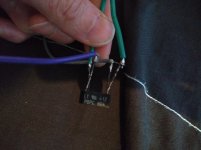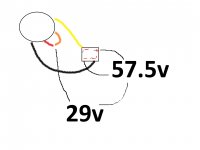Hi Guys,
I bought this Class A board. The auction states 28v is ok. On the board itself it says 33v +-
The auction also states 30va is good enough. So I bought a 50va 25v stuck it in the 6a (I think) bridge rectifier and got out 56v.
I presume this is 56v +- so I stuck it in the 33+- and got a loud buzzing.
I'm probably doing a thousand things wrong!
Thanks in advance!
I bought this Class A board. The auction states 28v is ok. On the board itself it says 33v +-
The auction also states 30va is good enough. So I bought a 50va 25v stuck it in the 6a (I think) bridge rectifier and got out 56v.
I presume this is 56v +- so I stuck it in the 33+- and got a loud buzzing.
I'm probably doing a thousand things wrong!
Thanks in advance!
Attachments
You do understand that the board needs DC voltage? I see you have a rectifier, but you also need some capacitors to store some energy if you expect it to work properly. If it is Class A, that toroidal is too small, you need 200-300VA minimum depending on wattage(current) you are hoping to get from the amplifier
Reread your post and yes...you have a number of things wrong.
You need a proper power supply
A proper toroidal - yours is too small current (VA) and too high voltage. You need a 200-300VA with 24-0-24, or dual 24V secondaries, depends what kind of power supply you go with.
You need a case to ground everything- for safety and for noise rejection.
You need a proper power supply
A proper toroidal - yours is too small current (VA) and too high voltage. You need a 200-300VA with 24-0-24, or dual 24V secondaries, depends what kind of power supply you go with.
You need a case to ground everything- for safety and for noise rejection.
I would be very surprised if the heat sinking is good for more than a watt or so. The comment about needing some significant capacitance is on the mark.
I would be very surprised if the heat sinking is good for more than a watt or so. The comment about needing some significant capacitance is on the mark.
+1, I assumed there were transistors/mosfets under the board, but I was wrong. Maybe your toroidal VA is OK, but you still need a power supply with capacitance.
You obviously wired it incorrectly - you should get 25 x 1.414 = 35vDC final DC voltage from it
Hi,
This is just a preamp board. The seller states that it only needs 28v+- and 30va to work. I got 24v 50va.
I have plenty of used capacitors. Will adding capacitors to my bridge rectifier work the preamp? If so some help on that would be greatly appreciated!
This is just a preamp board. The seller states that it only needs 28v+- and 30va to work. I got 24v 50va.
I have plenty of used capacitors. Will adding capacitors to my bridge rectifier work the preamp? If so some help on that would be greatly appreciated!
Just the bare transformer I get 62V or 2 x 31v. The transformer is only suppose to be 25V. But I have read it can go down when load is attached.
When I put the meter on the - and + of the bridge rectifier I get 56V
As I mentioned earlier - you have it wired wrong and we need more information on the transformer to help.
24VAC after the bridge should give you 66VDC if you measure across the +\-, but you add Capacitors to “set”your ground/“0” reference so you get +\-33 VDC - Still Too High Voltage from what the seller says, BUT could be close enough to not cause damage, but those transistors could run very hot trying to work at higher voltage if they don’t pop immediately.
Last edited:
Hard to read colors but you should take Yellow and Red to the AC on the bridge (corners marked with a ~)
Then you Orange and Black will make up your “0”.
If correct, probes to +/- on the rectifier should give you 66VDC and if you measure from the orange or black (black lead of DMM) to either side you should get EITHER +33 or -33 depending on which lead you probe on the rectifier. Being a preamp you might could get away without much capacitance, maybe 2200uF on each rail?
Then you Orange and Black will make up your “0”.
If correct, probes to +/- on the rectifier should give you 66VDC and if you measure from the orange or black (black lead of DMM) to either side you should get EITHER +33 or -33 depending on which lead you probe on the rectifier. Being a preamp you might could get away without much capacitance, maybe 2200uF on each rail?
I have been very remiss not starting with the disclaimer that voltage from the wall is dangerous and I hope you take all precautions before starting this project. Dim bulb tester?? Variac?
You need to stop and map everything out such that you will have a pretty clear idea of what will happen when the amp is plugged in.
I would make a light bulb tester just to be safe, is fairly common practice.
Probably need a fuse also, I always at the least put one before the transformer.
What is the voltage suggestion, ac or dc?
I would make a light bulb tester just to be safe, is fairly common practice.
Probably need a fuse also, I always at the least put one before the transformer.
What is the voltage suggestion, ac or dc?
You need to stop and map everything out such that you will have a pretty clear idea of what will happen when the amp is plugged in.
I would make a light bulb tester just to be safe, is fairly common practice.
Probably need a fuse also, I always at the least put one before the transformer.
What is the voltage suggestion, ac or dc?
I am extremely desperate just to get some sound out of it! 🙂
The voltage is after the bridge rectifier so DC.
I agree with fuses etc but main mission just to get it to work!
I am extremely desperate just to get some sound out of it! 🙂
The voltage is after the bridge rectifier so DC.
I agree with fuses etc but main mission just to get it to work!
At your own risk -
Assuming mains to your primaries are correct.
Take the Orange/Black to the “0” or center connection on the pre board, then you will run a wire from the “+” from your rectifier to the “+” on the board and then “-“ from your rectifier to the “-“ on the board.
This will make it run, but may not be the best set up, only the bare minimum to power it up.
Please be very careful with mains voltage.
Can you post your primary wiring too? I still think 56 is too low if everything is wired correctly. What’s your mains voltage? 240?
- Home
- Amplifiers
- Solid State
- Class A board DOA33. PSU Help!
